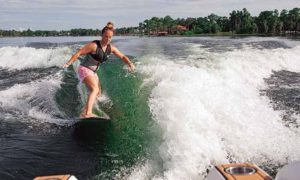Editor’s Note: Amy P. Smagula is Limnologist/Exotic Species Program Coordinator for the New Hampshire Department of Environmental Services.
Concord—June 22, 2020—Ballast. What is that? Ballast is something heavy added to the bottom compartment of a boat to help it sit lower and be more stable in the water. It could be something solid like weights or cargo added into the vessel, or more commonly, it could be surrounding water that is drawn into holding tanks on the vessel. The latter allows for quicker and more precise adjustment of weight, as water can be drawn in or pumped back out as needed.
Ballast has commonly been a term applied to large vessels, like cargo ships and ocean liners, which must sit low in the water to cross oceans and other large bodies of water safely. But, increasingly, ballast is a term used to describe a type of boat that is becoming popular on our lakes and pond: ballast boats, also known as wake boats.
These vessels are outfitted with water-holding devices (hard tanks or soft bags) with holding capacities ranging from 80 to 600 liters and plumbing to pump water in and out. While this may seem convenient and harmless, there is great concern about ballast water being a significant vector in the spread of aquatic invasive species, particularly microscopic organisms.
 A study from the Great Lakes Region (Campbell et al. 2016) examined ballast bags from 13 different vessels that had been docked for at least seven days. They found these bags could not be fully drained and contained residual amounts of water ranging from 1 to 87 liters. Of the 13 bags they examined, nine contained live aquatic organisms, two of which included live zebra mussel larvae.
A study from the Great Lakes Region (Campbell et al. 2016) examined ballast bags from 13 different vessels that had been docked for at least seven days. They found these bags could not be fully drained and contained residual amounts of water ranging from 1 to 87 liters. Of the 13 bags they examined, nine contained live aquatic organisms, two of which included live zebra mussel larvae.
This means that these vessels, with incomplete discharge of their ballast intake and typically no filtration or disinfection capabilities for the ballast system, could move water (and potentially harmful organisms) from one waterbody to another. We know a drop of lake water can contain thousands of organisms, and liters of water can contain hundreds of thousands of potentially problematic organisms!
In addition to moving volumes of water, these boats under the weight of ballast are heavy and sit low in the water. At operating speed for towing boarders and skiers or creating waves for surfers, they displace a lot of water, sending a series of tall waves across portions of the waterbody on which they are operating.
These waves have several times more energy than waves produced by un-ballasted ski vessels. This could lead to stirring up bottom sediments, shoreline erosion, nutrient loading and plant fragmentation, depending on how close to shore these vessels are operated.
To help understand positive and negative uses of ballast boats on our surface waters, a legislative study commission was formed in 2019. The commission was tasked with evaluating the science and mechanics of ballast boats and making recommendations to mitigate any potential impacts these vessels and their related ballast systems have on our surface waters. The commission is expected to report out this year.
As always, we encourage boaters to clean, drain, and dry, boats, trailers and gear using best available technologies and equipment to prevent the spread of invasive species. We encourage lake residents and other stewards to practice early detection activities by monitoring lakes for new infestations early, and to monitor for and document any sedimentation, erosion, or other concerns related to the multi-uses of our lakes.

Ban them on the lake. Not worth the long or even short term impact on the environment
These boats should be banned especially on the small bays they not only spread invasive species they created tremendous amount of shoreline erosion and property damage
I support the ban of these boats; they are eroding our shoreline. Our boat and our beach are pounded and destroyed every time one is on Berry Bay. People are not following the 150 foot rule—which is making it even worse.
We are on Berry Bay, within an area that is only 300 ft shoreline to shoreline. These boats come through and our beach is pounded and the sand is being pulled away. Roots are showing from our shoreline trees as well. Please do everything you can to ban these boats from the lakes. Thank you for your efforts Amy.
Yes, These boats make waves much larger than anything mother nature can produce in Berry bay and it eroding our shores. Now that I read how easily they can transfer invasive species, it makes me hate them even more.